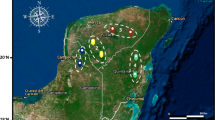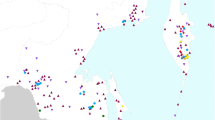Abstract
Benincasa hispida, from tropical Asia, is cultivated primarily for its edible fruit. To explore its domestication and ethnobotany, we made collections from two regions where it may have been domesticated: (1) Southern China/Southeast Asia, represented by southern Yunnan Province (China) and northern Laos; and (2) the Indian subcontinent, represented by southeastern Nepal. Domestication has resulted in diverse fruit sizes, shapes, and colors; seed sizes and shapes; and, in some accessions, the loss of tendrils. Modern cultivars have larger fruit, earlier flowers, and lower nutritional content than traditional cultivars. Allozyme diversity was low, divergence between these two regions was low, and these results do not clarify the place of domestication. The greater morphological diversity of plants from Yunnan and Laos, as compared to Nepal, suggests domestication in the former region. In all accessions, male flowers precede females.Benincasa hispida is prominent in some traditional stories and rituals.
Similar content being viewed by others
Literature Cited
Burkill, I. H. 1935. A dictionary of the economic products of the Malay Peninsula. Crown Agents for the Colonies, London.
Condon, M. A. and L. E. Gilbert. 1990. Reproductive biology and natural history of the Neotropical vinesGurania andPsiguria. Pages 151–166 in D. M. Bates, R. W. Robinson, and C. Jeffrey, eds., Biology and utilization of the Cucurbitaceae. Cornell University Press, Ithaca, NY.
DeCandolle, A. 1959. Origin of cultivated plants (reprint of the second edition, 1886). Hafner Pub- lishing Co., New York.
Decker-Walters, D. S. 1998. Sanskrit, Modern Indo-Aryan, and Dravidian names for Cucurbits. Occasional Papers of the Cucurbit Network No. 1. The Cucurbit Network, Miami, FL.
Doebley, J. 1989. Isozymic evidence and the evolution of crop plants. Pages 165–191 in D. E. Soltis and P. S. Soltis, eds., Isozymes in plant biology. Dioscorides Press, Portland, OR.
Heiser, C. B. 1979. The gourd book. University of Oklahoma Press, Norman, OK.
Hooker, J. D. 1973. The flora of British India, Vol. II (originally published 1876–1879). Reprinted by Bishen Singh Mahendra Pal Singh, New Connaught Place, Dehra Dun and Periodical Experts 42-D, Vivek Vihar, Delhi-32.
Jeffrey, C. 1980. A review of the Cucurbitaceae. Botanical Journal of the Linnaean Society 81: 233–247.
Li, H. L. 1970. The origin of cultivated plants of Southeast Asia. Economic Botany 24: 3–19.
Long, C. L, Y. H. Li, J. R. Wang, and S. J. Pei. 1995. Crop diversity in swidden agroecosystems of the Jin-uoshan in Xishuangbanna, China. Pages 151–157 in Pei Shengji and Percy Sajise, eds., Regional study on biodiversity: concepts, frameworks, and methods. Yunnan University Press, Kunming, China.
Majupuria, T. C. 1988. Religious and useful plants of Nepal and India. Craftsman press, Bangkok.
Marr, K. L., N. K. Bhattarai, and Y. M. Xia. 2005. Al-lozymic, morphological, and phenological diversity in cultivatedLuffa acutangula (Cucurbitaceae) from China, Laos and Nepal, and allozyme divergence betweenL. acutangula andL. aegyptiaca. Economic Botany 59: 154–165.
Marr, K. L. and Y. M. Xia. 2001.Benincasa hispida (Cucurbitaceae) the “Pumpkin” of Asian creation stories? Economic Botany 55: 575–577.
Marr, K. L, Y. M. Xia, and N. K. Bhattarai. 2004. Allozyme, morphological and nutritional analysis bearing on the domestication ofMomordica charantia L. (Cucurbitaceae). Economic Botany 58: 435–455.
—. 2005. Allozymic, phenological, linguistic, plant use and nutritional data on wild and cultivated collections ofLuffa aegyptiaca Mill. (Cucurbitaceae) from Nepal, southern China and northern Laos. Economic Botany 59: 137–153.
Matthews, P. J. 2003. Identification ofBenincasa hispida (wax gourd) from the Kana archaeological site, western Highlands Province, Papua New Guinea. Archaeology in Oceania 38: 186–191.
Muke, J. and H. Mandui. 2003. In the shadows of Kuk: Evidence for prehistoric agriculture at Kana, Wahgi Valley, Papua New Guinea. Archaeology in Oceania 38: 177–185.
Nazimuddin, S. and S. S. H. Naqvi. 1984. Cucurbitaceae. Pages 1–56 in E. Nasir and S. I. Ali, eds., Flora of Pakistan. Pakistan Agricultural Research Council, Islamabad.
Nei, M. 1978. Estimation of average heterozygosity and genetic distance from a small number of individuals. Genetics 89: 583–590.
Prabhakar, J. 1995. Ethnobotany of the primitive tribes of Rajasthan. Offset Printers, Jaipur, India.
Pyramarn, K. 1989. New evidence on plant exploitation and environment during the Hoabinhian (Later Stone Age) from Ban Kao Caves, Thailand. Pages 282–291 in D. R. Harris and G. C. Hillman, eds., Foraging and farming: The evolution of plant exploitation. Unwin Hyman, London.
Rifai, M. A. and M. E. C. Reyes. 1993.Benincasa hispida (Thunbergex Murray) Cogniaux. Pages 95–97 in J. S. Siemonsma and K. Piluek, eds., Plant resources of South-East Asia, No. 8. Vegetables. Pudoc Scientific Publishers. Wageningen, The Netherlands.
Roy, R. P. and S. Saran. 1990. Sex expression in the Cucurbitaceae. Pages 251–268 in D. M. Bates, R. W. Robinson, and C. Jeffrey, eds., Biology and utilization of the Cucurbitaceae. Cornell University Press, Ithaca, NY.
Singh, A. K. 1990. Cytogenetics and evolution in the Cucurbitaceae. Pages 10–28 in David M. Bates, Richard W. Robinson, and Charles Jeffrey, eds., Biology and utilization of the Cucurbitaceae. Cornell University Press, Ithaca, NY.
Swofford, D. L. and R. B. Selander. 1989. BIOSYS-1: A computer program for the analysis of allele variation in population genetics and biochemical sys-tematics (Release 1.7). Natural History Survey, Champaign, IL.
SYSTAT. 1997. Version 7.0.1 for windows. SPSS Inc. 7/97; 233 South Wacker Drive, 11th Floor, Chicago, IL.
Trankell, I.-B. 1995. Cooking, care, and domestication. A culinary ethnography of the Tai Yang, Northern Thailand. Acta Universitatis Upsaliensis, Uppsala Studies in Cultural Anthropology 21. Gotab, Stockholm, Sweden.
Walters, D. S. and T. W. Walters. 2000. The BobbingBenincasa. The Cucurbit Network News 7: 1–2.
Walters, T. W. 1989. Historical overview on domesticated plants in China with special emphasis on the Cucurbitaceae. Economic Botany 43: 297–313.
Walters, T. W. and D. S. Decker-Walters. 1989. Systematic re-evaluation ofBenincasa hispida (Cucurbitaceae). Economic Botany 43: 274–278.
Whistler, W. A. 1990. The other Polynesian gourd. Pacific Science 44: 115–122.
Wills, R. B. H., A. W. K. Wong, F. M. Scriven, and H. Greenfield. 1984. Nutrient composition of Chinese vegetables. Journal of Agricultural and Food Chemistry 32: 413–416.
Yang, S. L. and T. W Walters. 1992. Ethnobotany and the economic role of the Cucurbitaceae in China. Economic Botany 46: 349–367.
Author information
Authors and Affiliations
Rights and permissions
About this article
Cite this article
Marr, K.L., Xia, YM. & Bhattarai, N.K. Allozymic, morphological, phenological, linguistic, plant use, and nutritional data ofBenincasa Hispida (Cucurbitaceae). Econ Bot 61, 44–59 (2007). https://doi.org/10.1663/0013-0001(2007)61[44:AMPLPU]2.0.CO;2
Accepted:
Issue Date:
DOI: https://doi.org/10.1663/0013-0001(2007)61[44:AMPLPU]2.0.CO;2




